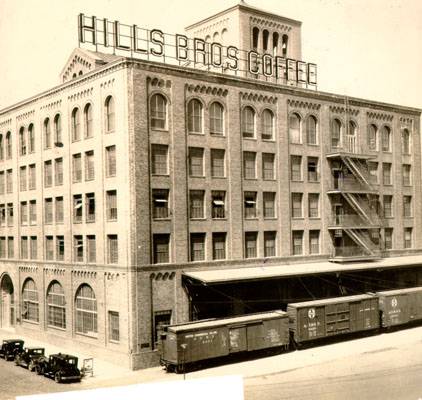HILLS BROTHERS COFFEE: Difference between revisions
(added photo) |
mNo edit summary |
||
| Line 7: | Line 7: | ||
'''Hills Brothers Coffee, 1940.''' | '''Hills Brothers Coffee, 1940.''' | ||
''Photo: San Francisco History Center, | ''Photo: San Francisco History Center, San Francisco Public Library'' | ||
| Line 21: | Line 21: | ||
'''"Hills Bros. Building, San Francisco, Date: Dec. 15, 1924" | '''"Hills Bros. Building, San Francisco, Date: Dec. 15, 1924" | ||
''Photo: San Francisco Museum and Historical Society'' | |||
| Line 28: | Line 28: | ||
'''The former Hills Brothers Coffee Building on the Embarcadero at Folsom, mid-1990s.''' | '''The former Hills Brothers Coffee Building on the Embarcadero at Folsom, mid-1990s.''' | ||
''Photo: Chris Carlsson | ''Photo: Chris Carlsson'' | ||
Embarcadero and Folsom: One of main industries that sprung up early in SOMA was the coffee industry. Starting in the late 19th century, San Francisco had become the largest west coast coffee provider by the 1920s, including companies like Hills Bros, Folgers, and MJB. This industry provided the first link between San Francisco and Central America, where the coffee was grown. Following the industry, Central American laborers came to San Francisco in the early 20th century to work in processing plants and canneries. This explains San Francisco's unique connection to Central America, when most other California cities are historically predominantly Mexican. Most people think that Central Americans first came to San Francisco in the 1960s to 1980s, with the wars in Nicaragua and El Salvador, but many chose to come here because they already had family connections and community links going back to the early part of this century. | Embarcadero and Folsom: One of main industries that sprung up early in SOMA was the coffee industry. Starting in the late 19th century, San Francisco had become the largest west coast coffee provider by the 1920s, including companies like Hills Bros, Folgers, and MJB. This industry provided the first link between San Francisco and Central America, where the coffee was grown. Following the industry, Central American laborers came to San Francisco in the early 20th century to work in processing plants and canneries. This explains San Francisco's unique connection to Central America, when most other California cities are historically predominantly Mexican. Most people think that Central Americans first came to San Francisco in the 1960s to 1980s, with the wars in Nicaragua and El Salvador, but many chose to come here because they already had family connections and community links going back to the early part of this century. | ||
Revision as of 14:19, 28 October 2013
Unfinished History
courtesy Northern California Coalition on Immigrant Rights
Hills Brothers Coffee, 1940.
Photo: San Francisco History Center, San Francisco Public Library
"Office, Factory and Selling Force Hills Bros. 1882"
Photo: San Francisco Museum and Historical Society
"Hills Bros. Building, San Francisco, Date: Dec. 15, 1924"
Photo: San Francisco Museum and Historical Society
The former Hills Brothers Coffee Building on the Embarcadero at Folsom, mid-1990s.
Photo: Chris Carlsson
Embarcadero and Folsom: One of main industries that sprung up early in SOMA was the coffee industry. Starting in the late 19th century, San Francisco had become the largest west coast coffee provider by the 1920s, including companies like Hills Bros, Folgers, and MJB. This industry provided the first link between San Francisco and Central America, where the coffee was grown. Following the industry, Central American laborers came to San Francisco in the early 20th century to work in processing plants and canneries. This explains San Francisco's unique connection to Central America, when most other California cities are historically predominantly Mexican. Most people think that Central Americans first came to San Francisco in the 1960s to 1980s, with the wars in Nicaragua and El Salvador, but many chose to come here because they already had family connections and community links going back to the early part of this century.
The Hills Brothers Factory has since been converted to offices, condominiums and a microbrewery catering to the new upscale South Beach professional clientele.




